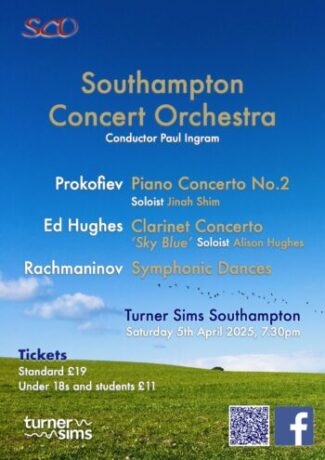 United Kingdom Hughes, Prokofiev, Rachmaninov: Alison Hughes (clarinet), Jinah Shim (piano), Southampton Concert Orchestra / Paul Ingram (conductor). Turner Sims Concert Hall, Southampton, 5.4.2025. (CK)
United Kingdom Hughes, Prokofiev, Rachmaninov: Alison Hughes (clarinet), Jinah Shim (piano), Southampton Concert Orchestra / Paul Ingram (conductor). Turner Sims Concert Hall, Southampton, 5.4.2025. (CK)

Ed Hughes – Clarinet Concerto, Sky Blue
Prokofiev – Piano Concerto No.2
Rachmaninov – Symphonic Dances
I first heard Ed Hughes’s wonderful Clarinet Concerto Sky Blue in a concert given by the St Paul’s Sinfonia in February last year, in St Alfege Church in Greenwich, with Alison Hughes as soloist: it was a real treat to hear it again, with the same soloist, more or less on my doorstep. It is a twenty-minute work in three movements, fast-slow-fast; the solo clarinet interacts with the whole orchestra in the fast outer movements, and with the strings alone in the slow movement.
The title is taken from an extraordinary painting: if you were asked to guess the artist you might say Miró or Klee, but it is actually by Kandinsky. In its freewheeling fantasy it looks like the work of a young man, but Kandinsky was 74 when he painted it: there is nothing to suggest the brevity of life or the imminence of death in its humorous ballet of weightless, fantastical, colourful, cartwheeling organisms.
Why waste column inches on the picture from which the music derives? Because when the piece is on CD, as I hope it will be – CD’s are almost obsolete, I know, but I am even older than Kandinsky was, and slow to change my ways – even if I had the score or a detailed musical analysis to hand I would rather have the picture in front of me as I listened.
The concerto is a tour de force for the clarinet: the solo part takes flight and stays airborne throughout, skirling, swooping, making fanciful, exotic, dreamlike shapes and patterns in the air. I imagine that the music makes extreme demands – the clarinet cavorting high above the orchestra like a trapeze artist or darting like a bird – but in Alison Hughes’s hands it all sounded natural, a stream of joy.
Equally revelatory, in this performance, was the beauty of the orchestral writing. It is never predictable, and there is a constant variety – and, often, complexity – of rhythm and colour; sometimes an instrument seems to detach and accompany the clarinet for a while. Every detail was clear (including the first movement’s wonderful tuba part).
Southampton Concert Orchestra’s string section was twice the size of the St Paul’s Sinfonia’s: in the slow central movement this made for gorgeous sounds. As I listened to a slow, hypnotically falling scale in the cellos, I wondered how rich should this complex, floating tissue of orchestral sound be? Lean and light? I was too entranced by the music’s sheer beauty to pursue the matter.
It is only a few weeks since I heard the British-Korean pianist Jinah Shim play both Shostakovich piano concertos (plus his lesser-known Concertino for Two Pianos) in the course of the day-long Shostakovathon here in the Turner Sims: in this concert she took on perhaps the fiercest Russian piano concerto of them all, Prokofiev’s Second. It calls for staggering virtuosity; but Shim (forgive the Trumpspeak) held all the cards. Four movements, two cadenzas; the first of them, at the end of the first movement, absolutely huge (Prokofiev marked its climax Colossale). One could only listen open-mouthed as Shim tore it up; mentally I was adapting a well-known line from a Hollywood blockbuster for her: ‘You’re gonna need a bigger piano.’
The young Prokofiev plainly wanted to épater le bourgeois and show off his own virtuosity at the same time: audiences were duly astonished, and still are. There is no proper slow movement, and no respite: the brief Scherzo is a fast moto perpetuo teeming with notes, and the Intermezzo is no such thing, with its trudging double basses, lumbering heavy brass and disjointed piano. In the last movement a suspicion of empty note-spinning perhaps creeps in, but the performance was an unqualified triumph for Shim, and for conductor Paul Ingram and the orchestra as well.
This demanding programme culminated in a rousing, glittering performance of Rachmaninov’s Symphonic Dances: orchestrally his last testament, and, despite its cheerful title, a work of dark brilliance and sophistication. Ingram and the orchestra rose to the challenge magnificently. In the first movement we were able to savour the beauty of the music for the woodwinds (augmented by a saxophone, introducing a seductive and faintly troubling element to the overall sound), the references to the First Symphony, whose disastrous premiere had all but broken the composer, and the appearance of the Dies Irae plainchant, which haunts this work as it does many others among Rachmaninov’s oeuvre.
A dissonant fanfare on muted horns and trumpets gives way, in the second movement, to a waltz that seems not to flow but to drag itself along, to remain doggedly earthbound; the oboe (Nickie Smith), prominent in the first movement, again stood out from the woodwind choir, and Ingram and the whole orchestra built a powerful intensity towards the movement’s close. And at the end of a taxing programme the players were equal to the considerable demands Rachmaninov places on them in the finale: it was truly impressive, with deft playing by principal horn (John Peskett) and trumpet (Tom Kidman) – and also the xylophone, played by one of the busy percussion section. Ingram tightened the screw skilfully and inexorably in the long approach to the mighty conclusion; we were suitably stunned (where did they get that huge gong?). A triumphant end to a concert I will long remember.
Chris Kettle
